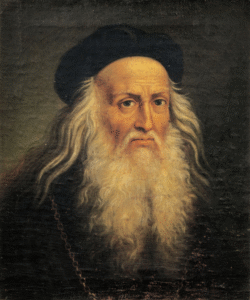
Leonardo da Vinci Biography – Discover the extraordinary life of Leonardo da Vinci, the Renaissance genius known for his artistic masterpieces, scientific discoveries, and groundbreaking inventions. Learn about his early life, famous works, inventions, and legacy.
Leonardo da Vinci was one of history’s greatest minds, renowned as a painter, inventor, scientist, and engineer. His works, including Mona Lisa and The Last Supper, continue to captivate the world centuries after his time. Beyond art, da Vinci’s contributions to anatomy, engineering, and aviation were far ahead of his era.
His insatiable curiosity and creative genius made him a true Renaissance man, shaping the future of multiple disciplines.
Leonardo da Vinci Biography: Profile Summary
| Field | Details |
|---|---|
| Name | Leonardo di ser Piero da Vinci |
| Profession | Painter, Inventor, Engineer, Scientist, Architect |
| Nationality | Italian |
| Age | Passed away at 67 years (April 15, 1452 – May 2, 1519) |
| Education | Apprenticeship under Andrea del Verrocchio |
| Net Worth | Not applicable (historical figure) |
| Famous For | Mona Lisa, The Last Supper, Vitruvian Man, inventions |
| Family | Father: Ser Piero da Vinci, Mother: Caterina |
| Wife | Never married |
| Notable Inventions | Flying machine, war machines, anatomical studies |
| Death | May 2, 1519, in Amboise, France |
Important Facts
- Artistic Masterpieces: Mona Lisa and The Last Supper are among the world’s most famous paintings.
- Inventor Ahead of His Time: Designed early versions of helicopters, tanks, and scuba gear.
- Scientific Genius: Made significant contributions to anatomy, physics, and hydraulics.
- Self-Taught Polymath: His knowledge spanned multiple fields, despite having no formal higher education.
- Unfinished Works: Many of his projects, including paintings and engineering designs, were never completed.
Early Life and Education

Leonardo da Vinci was born on April 15, 1452, in Vinci, a town in present-day Italy. He was the illegitimate son of Ser Piero da Vinci, a notary, and a peasant woman named Caterina. Despite lacking a formal academic education, Leonardo showed an early interest in nature, drawing, and mechanics. At the age of 14, he began an apprenticeship under the renowned artist Andrea del Verrocchio in Florence, where he mastered painting, sculpture, and engineering skills.
Career and Inventions
Leonardo’s career spanned multiple disciplines. He worked for the Duke of Milan from 1482 to 1499, producing remarkable artworks and designing military machines. His notebooks contained sketches of inventions like flying machines, bridges, and even early concepts for submarines. However, many of his ideas were never built during his lifetime.
Famous Paintings
- Mona Lisa (1503–1519) – The world’s most famous painting, known for its enigmatic smile.
- The Last Supper (1495–1498) – A mural depicting Jesus and his disciples at the moment of betrayal.
- Vitruvian Man (1490) – A study of human proportions that remains an iconic image of science and art.
- Lady with an Ermine (1489–1490) – A portrait demonstrating Leonardo’s skill in realism.
Da Vinci’s Drawings and Notebooks
Leonardo filled thousands of pages with sketches, scientific observations, and engineering ideas. His anatomical studies revolutionized the understanding of the human body. His drawings of birds and flight mechanics also contributed to modern aerodynamics.
The Last Supper and Its Significance
The Last Supper, painted between 1495 and 1498 in Milan’s Convent of Santa Maria delle Grazie, is one of the most studied and restored artworks in history. It captures the dramatic moment when Jesus announces his betrayal, with each disciple showing a distinct emotional reaction.
Museums and Airports Named After Leonardo da Vinci
Leonardo’s legacy is honored worldwide:
- Louvre Museum, Paris: Houses Mona Lisa and many of his works.
- Leonardo da Vinci–Fiumicino Airport, Rome: Italy’s largest airport is named after him.
- Museo Leonardo da Vinci, Florence: Showcases models of his inventions and scientific studies.
Quotes by Leonardo da Vinci
- “Learning never exhausts the mind.”
- “Simplicity is the ultimate sophistication.”
- “The noblest pleasure is the joy of understanding.”
- “Art is never finished, only abandoned.”
Personal Life and Family
Leonardo never married or had children. He maintained close friendships with artists and intellectuals, and his relationships with his assistants, such as Salai and Francesco Melzi, were particularly significant. Melzi inherited most of Leonardo’s works and manuscripts after his death.
Death and Legacy
Leonardo da Vinci passed away on May 2, 1519, in Amboise, France, at the age of 67. His contributions to art, science, and engineering continue to inspire scholars and innovators today. His notebooks provide a window into the mind of a genius who was centuries ahead of his time.
Conclusion
Leonardo da Vinci was a visionary whose impact spanned multiple disciplines. His masterpieces, innovative ideas, and scientific curiosity shaped the world in ways that remain relevant today. Whether through his paintings, engineering designs, or anatomical studies, his genius continues to captivate and influence modern society.
FAQs About Leonardo da Vinci
1. What was Leonardo da Vinci famous for?
He was famous for his paintings (Mona Lisa, The Last Supper), scientific studies, and inventions.
2. Did Leonardo da Vinci have a wife?
No, he never married or had children.
3. What was Leonardo da Vinci’s most famous invention?
His flying machine design, which inspired modern aviation.
4. Where can I see Leonardo da Vinci’s artwork?
The Mona Lisa is displayed at the Louvre Museum in Paris, and The Last Supper is in Milan’s Santa Maria delle Grazie.
5. What was Leonardo da Vinci’s cause of death?
He died of natural causes in 1519 in France.
6. Is there a museum dedicated to Leonardo da Vinci?
Yes, museums in Italy and France showcase his inventions and artworks, such as Museo Leonardo da Vinci in Florence.
7. Why is The Last Supper so important?
It is considered a masterpiece for its composition, perspective, and emotional depth.
8. What was Leonardo da Vinci’s last known work?
St. John the Baptist (1513–1516) is believed to be his final painting.





